article by essayist extraordinaire, Tom Simon
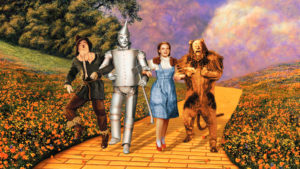
I have spent the last week or so (when not sleeping off my medications) in a fairly continuous process of brainstorming, chewing over several new-to-me ideas and figuring out how to turn them into actual writing techniques.
 I forget exactly what prompted me to revisit the Key & Peele skit I reposted some time ago, in which the duo performed a thorough piss-take on the silly (and often self-inflicted) names one so often sees among American football players. Of all the daft monikers they introduced to the world, one in particular seems to have caught the public imagination: ‘Ozamataz Buckshank’. The name Ozamataz has been ‘repurposed’ for any number of online game characters and social-media personas. I think part of the reason lies in the delivery: in the original skit, the name was pronounced in a drawl reminiscent of Jimmy Stewart. It is, in fact, a fun name to say aloud, and I think that contributes to its popularity. But there may be more to it than that. A name like ‘Jackmerius Tacktheritrix’ or ‘Javaris Jamar Javarison-Lamar’ is too Pythonesque, too blatant in its silliness, to have much staying power. ‘Ozamataz’ is almost, but not quite, realistic; it could plausibly be an actual word.
I forget exactly what prompted me to revisit the Key & Peele skit I reposted some time ago, in which the duo performed a thorough piss-take on the silly (and often self-inflicted) names one so often sees among American football players. Of all the daft monikers they introduced to the world, one in particular seems to have caught the public imagination: ‘Ozamataz Buckshank’. The name Ozamataz has been ‘repurposed’ for any number of online game characters and social-media personas. I think part of the reason lies in the delivery: in the original skit, the name was pronounced in a drawl reminiscent of Jimmy Stewart. It is, in fact, a fun name to say aloud, and I think that contributes to its popularity. But there may be more to it than that. A name like ‘Jackmerius Tacktheritrix’ or ‘Javaris Jamar Javarison-Lamar’ is too Pythonesque, too blatant in its silliness, to have much staying power. ‘Ozamataz’ is almost, but not quite, realistic; it could plausibly be an actual word.
And so, hearing the name again, I asked myself: If ozamataz were a word, what would it mean?
It is fairly clear, at least, how Key & Peele (or their writers) came up with the name. It is a portmanteau of Oz with razz(a)matazz. My handy Oxford dictionary app defines the latter word: ‘noisy, showy, and exciting activity and display designed to attract and impress’. Oz, of course, was the name (or title) of the great and powerful and eponymous Wizard, whose magic consisted of little else but razzmatazz. Ozamataz must be the kind of razzmatazz in which the Wizard of Oz specialized.
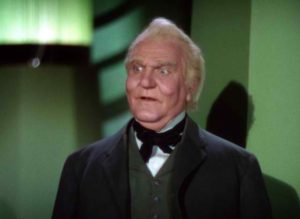
Oz the wizard
Oz, by his own admission, was a humbug. He was, he insisted, a very good man, but a very bad wizard. This gave him an endearing quality that one does not usually find among frauds and con men. Dorothy and her friends very much wanted his magic to be real; and the Wizard’s three bits of real magic all worked powerfully on that desire, and gave three of the lead characters their hearts’ desires through a cunning twist on the placebo effect. The film, in this respect, is better than the book. Oz gave them recognition for the qualities that they actually had, but believed themselves to lack entirely: a diploma for the Scarecrow, a testimonial for the Tin Woodman, a medal for the Cowardly Lion. Alas, no amount of recognition could send Dorothy back to Kansas: placebos have their limits. But we leave Oz with the feeling that the Wizard not only meant well, but did well and even ruled well; even though his magic was three 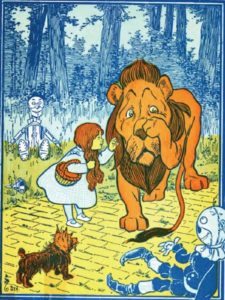 parts bluff and one part showmanship.
parts bluff and one part showmanship.
The American children who made up L. Frank Baum’s original readership felt this quality keenly. None of Baum’s other books were very successful, but children took Oz to their hearts. They loved the Scarecrow and the Tin Woodman precisely for the brain and heart that they themselves never knew they had; and they loved the Wizard for the very real magic that he could do, despite thinking of himself as a humbug. Literature is full of characters who are merely flawed. The heroes of Oz are heroic precisely because of the battles they fight to overcome their flaws – battles that they win, generally speaking, without knowing it.
Baum did not want to write any sequels to The Wonderful Wizard of Oz. It was the children who made him do it. After several years, he gave in to the overwhelming pressure of his fan mail (and the dead, gloomy silence with which his other works were received), and wrote The Land of Oz, a brilliantly successful sequel, and a comic-strip spinoff, which was successful without being brilliant. Still further delays followed before he began the long string of Oz sequels from Ozma of Oz to Glinda of Oz, the fourteenth book in the series. He then died; but Oz did not die with him.
On the whole, none of the sequels matched the quality of the first two books. At the time, Oz was something fresh: a joyous head-on collision between the traditional European fairy tale, with its trappings of magic and royalty, and the anarchic humour of the American tall tale. The first Oz books represent a spree of inventiveness never seen in either of those literary forms, and seldom rivalled in the fantasy genre of later times. After that, Baum had to ration out his creativity more carefully. Most of the later Oz books have glimmers of the original brilliance, enough (eked out with shameless recycling of the original material) to keep the fans entertained and the letters (and royalties) coming in.
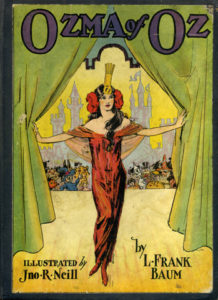 The later books are somewhat spoilt by sentimentality. Baum kept dragging in the Scarecrow and Tin Woodman long after he had run out of things to say about them, because the children demanded it. In the fourth book, straightforwardly entitled Dorothy and the Wizard in Oz, he brought back the two leading characters from the first book, and completed the ensemble. Ozma taught the Wizard real magic, and Dorothy made her permanent home in Oz; and that, though it was just what the fans had asked for, killed them both. The essence of the Wizard is that he was a humbug who accomplished good and great deeds by clever fakery; the essence of Dorothy is that she wanted to go home. Without their essence, all that remained was a rather twee appearance. But if the fans of Oz could tell the difference, they were not experienced or critical enough to tell why the revived Wizard and Dorothy were less successful than the originals.
The later books are somewhat spoilt by sentimentality. Baum kept dragging in the Scarecrow and Tin Woodman long after he had run out of things to say about them, because the children demanded it. In the fourth book, straightforwardly entitled Dorothy and the Wizard in Oz, he brought back the two leading characters from the first book, and completed the ensemble. Ozma taught the Wizard real magic, and Dorothy made her permanent home in Oz; and that, though it was just what the fans had asked for, killed them both. The essence of the Wizard is that he was a humbug who accomplished good and great deeds by clever fakery; the essence of Dorothy is that she wanted to go home. Without their essence, all that remained was a rather twee appearance. But if the fans of Oz could tell the difference, they were not experienced or critical enough to tell why the revived Wizard and Dorothy were less successful than the originals.
Baum’s death did not end the clamour for more Oz books. The series was handed off to Ruth Plumly Thompson, who wrote more than twenty books in the series before tiring of her own formula. She gave it up in 1939, the very year that the film version of The Wizard of Oz brought Baum’s creation to a new mass audience. The series was then continued by John R. Neill, who had illustrated every book from The Land of Oz on. Neill wrote three more books before his own death.
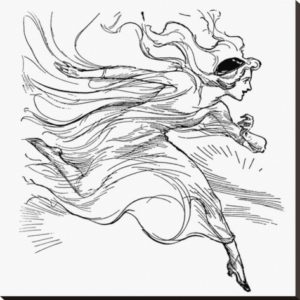
Polychrome, the rainbow’s daughter, by John Neill
At this point, Ozamataz begins to resemble Ouroboros, the world-serpent biting its own tail. The next author of an official Oz book (after the hiatus of the Second World War) was Jack Snow, who had been a twelve-year-old Oz fan when Baum died, and became a Baum scholar when he grew up. The fans had captured the citadel; and they have been there ever since. In the 1970s, two more of Ruth Plumly Thompson’s books were published by the International Wizard of Oz Club; this fan organization went on to print many more Oz books over the following decades. Most recently, Sherwood Smith’s three Oz sequels have been officially recognized by the Baum family trust.
On the other hand, Gregory Maguire’s revisionist retelling, Wicked and its sequels, has been officially snubbed, for good reason. The moral of Wicked, as of so much modern nihilist fantasy, could be summed up in a sentence: ‘Evil is Cool, and anyway, it was forced to be Evil because Good is Even Worse.’ This is a sentiment that Baum (like nearly all of his generation) would have regarded with plain horror.
And then there is the straightforward Oz fan fiction, not commercially published, and not officially recognized or deprecated by anyone.
We can say that Ozamataz, the peculiar fake-but-effective magic of the Wizard, leaked out of the books, made its tour through the lively century-long phenomenon of Oz fandom, and eventually came full circle as the fans grew up to write Oz books themselves.
In this wider or larger sense, ozamataz could be defined as the particular blend of creativity and publicity that inheres in a self-sustaining fandom, which has the power to call forth new work in the canon if the original authors cease to supply it.
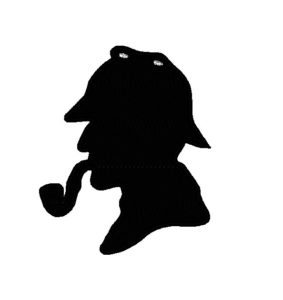
Sherlock, another Ozamatazian
Oz, of course, is not the only franchise with this kind of ozamataz. Sherlock Holmes was a still earlier example. Arthur Conan Doyle thought he had done with his famous consulting detective when he killed him off at the Reichenbach Falls; but the fans would not let ill alone, and forced him to go on writing stories about the resurrected Holmes for thirty more years. Since then, everyone and his dog has had a go at writing unofficial Holmes stories. The pastiches are beyond counting, from Sexton Blake to House and Sherlock.
Several of the modern media franchises have definite ozamataz. Star Trek, after the early cancellation of the original series, was kept alive by fan fiction, and Pocket Books’ line of Trek novels became a stepping-stone for many young science fiction writers of the 1970s and 80s. Today, the Trek franchise has entirely escaped the de facto control, though not the de jure ownership, of Paramount Studios. Groups of fans from America to Turkey have produced films in the style of the original series, some as remakes of the original scripts, some with new material written for the purpose.
Read the rest of this fascinating essay, as he talks about Dr. Who, Star Wars, and more, on Bondwine


